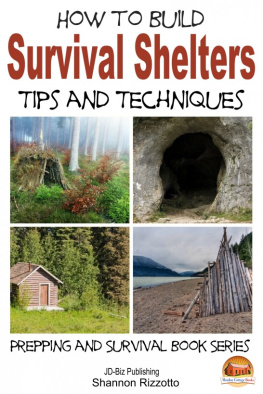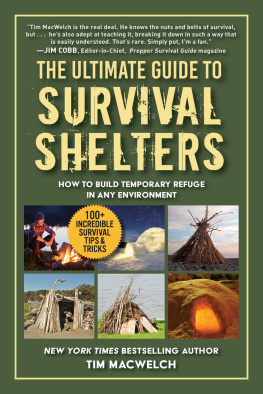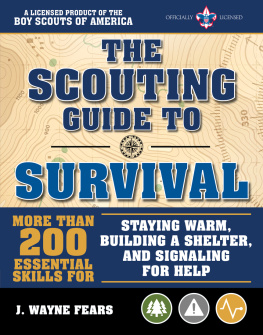How to Build Survival Shelters
Tips and Techniques

Shannon Rizzotto
Prepping and Survival Book Series
~~~
Smashwords Edition
Mendon Cottage Books

JD-Biz Publishing
All Rights Reserved
No part of this publication may be reproducedin any form or by any means, including scanning, photocopying, orotherwise without prior written permission from JD-Biz CorpCopyright 2014
All Images Licensed by Fotolia and 123RF
Disclaimer
The information in this book is provided forinformational purposes only and it is not intended for use as asubstitute for proper financial or legal direction by a qualifiedfinancial or legal advisor. The information is believed to beaccurate as presented based on research by the author.
The author or publisher is not responsiblefor financial loss or damage incurred by implementing ideasmentioned in this book. The author or publisher is not responsiblefor errors or omissions that may exist.
Smashwords Edition, License Notes
This ebook is licensed for your personalenjoyment only. This ebook may not be re-sold or given away toother people. If you would like to share this book with anotherperson, please purchase an additional copy for each recipient. Ifyoure reading this book and did not purchase it, or it was notpurchased for your use only, then please return to your favoriteebook retailer and purchase your own copy. Thank you for respectingthe hard work of this author.
Warning
The Book is for informational purposes onlyand before starting or running any activity or business, it isrecommended that you consult with your financial or legalprofessional. Always follow all laws and regulations mentioned inthis book regarding activities, taxes, selling, buying, orecommerce.
Table of Contents
Introduction
A disaster strikes. You have no home. You arelost in the wilderness. You need shelter but, what do you do? Wheredo you build it and how?
This book is designed to take you the readerinto those very scenarios and to show you exactly what to do whenthese situations strike and how to build a shelter, tee-pee,lean-to, or even a small cabin for safety, warmth, and shelter fromthe elements.
In any survival situation your means are veryprimitive. It is up to you to have the wit and the ability toprovide for yourself and the possibility of others. With the helpof this book you will learn the basics on how to construct survivalshelters.
Survival is something few know how to do oruse to their benefit. In this day and age many people are used togoing to the store for everything they need and have no idea how todo many of the things our not so distant relatives once knew how todo. Many of the basic survival techniques including building ofshelters has all but been forgotten. It is the hope of the authorthat if a situation strikes and you need shelter of any kind. Thisbook will give you a better understanding of what it takes toprocure material, and build your structure.
Not all situations are the same. Far from itand, not every location offers the same building material.Ultimately it is up to you to find a way and the materials to buildany structure. With enough creativity and the know how along withthe examples given in this book you should be able to construct abasic shelter in no time at all.
ChapterOne
Building aLean-To

What would you do if you were in a situationwhere you needed immediate shelter and you needed it with a fairlyquick amount of time? Would you know what to do? Could you doit?
The first thing we will talk about in thisbook is how to build a simple lean-to. These types of shelter havebeen used for hundreds if not thousands of years and are by far theeasiest to construct with the most limited of supplies. A lean-tocan be made of most anything you find. If in an urban environment.You can use most any debris from storms that have damaged houses orbuildings. Pieces of drift wood, sticks, branches, poles, fences,tarps, garbage bags, and the list goes on and on. Really, theability to craft one is endless. That said, we will talk aboutconstructing a single person lean-to dwelling. This will be simpleto construct because much like its name, a lean-to, leans. Thereis very little construction in producing one of these for yourselfand this is how you do it.
First, you will want to find an area suitablefor the lean-to. The best place in the wilderness would be againsta large tree or a large rock or boulder. In the urban environment,you can build one against a building. Near a bridge or under it forthat matter. Alongside a vehicle or truck. Pretty much anyplace youcan find at least one wall or one area that is solid and will notmove.
Next, you will want to find 3-5 suitablepoles of some kind. These can be made from any material and about5-6 feet in length is ideal. Once you have located these items youwill set them up against your base structure or the wall in theurban environment. The same goes for those of you in thewilderness. You do the same with the large tree or rock as yourbase and use the same amounts of branches or young saplings and youwill cut them to 5-6 feet in length. Now, in either environment,you will place these poles about eight inches apart so with 6 polesyou are covering about 48 inches. You can use more poles if youlike but keep each eight inches from the others up to any lengthyou see fit. The reason I suggested using only six poles is becauseyou will have a smaller surface area to keep warm if you need to dothat. That said, once you have the poles set up you are going towant to keep one end of the lean-to closed. This can be either theright or the left it really does not matter. You can keep it closedoff my piling sticks against its end or using a tarp. You canrotate the closure as well if you like really, that is up toyou.
Once you have your end closed up you canstart to fill in the slots on the front of your structure betweenthe poles you already have set in place. To fill the slots betweenthe polls you can use tarps, blankets, pallets, branches, sticks,basically whatever you can find. In a lot of ways the structure youare building will not be very eye appealing but, it will certainlykeep you out of the elements and safe from whatever the out ofdoors may bring. You can fill in the slots vertical or horizontal,however you like. I would say to do it the opposite of whatever wayyou have the base poles set up. This way it will be woven togetherin some ways and you dont risk having the structure fall on you inyour sleep, during a storm, or if the wind blows hard enough. Youcan also build this type of shelter as described but you can builda floor or raised deck within it so the critters that crawl atnight do not get on you. The best way to do this is to place logsor other collected debris from the urban environment on the floorto keep it raised enough to not only keep the bugs away but, youcan also keep moisture and the possibility of rain and other waterto creep in and get you wet.
Now there are other designs you can build inthis basic same manner one of them would be the Teepee. A teepee isbuilt with longer poles about ten feet or more in length and formedinto a circle at the base and to a point with all the polesintersecting each other at the top. The structure is traditionallythen wrapped in animal hides however this is a massive undertakingif you have no hides to start with. You can also use canvas,tarp/s, or even more poles that make up the same length as the basepoles to cover all the slits in the side of your teepee. You wantto make sure you leave a small opening in the front that you canget in and out from otherwise you have created nothing more than abonfire pile. Which by the way is not a bad idea if you are lost inthe wilderness or are trying to get help and no one has any ideawhere you are. People always investigate smoke and smoke signalshave been used for hundreds of years to bring attention to andarea. Be very careful once you have created your lean-to or teepeeto keep all fire and spark away from your structure. Fire can alsobe the enemy and in this case you want to be safe without hurtingyourself or anyone else around you.














